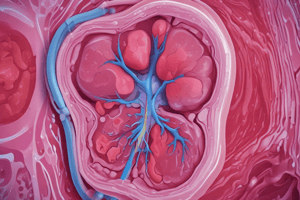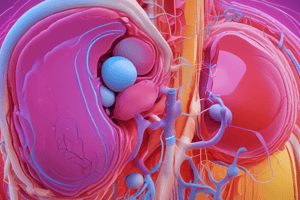Podcast
Questions and Answers
What structure is the cauda equina complex composed of?
What structure is the cauda equina complex composed of?
- Muscles and ligaments
- Skin and hair follicles
- Blood vessels and glands
- Nerve roots and other connective tissue (correct)
Which condition can result from dilation of the veins within the cauda equina complex?
Which condition can result from dilation of the veins within the cauda equina complex?
- Cauda equina syndrome (correct)
- Scoliosis
- Herniated disc
- Sciatica
What symptoms may be present in a person with cauda equina syndrome?
What symptoms may be present in a person with cauda equina syndrome?
- Constipation and nausea
- Leg weakness and fecal incontinence (correct)
- Shoulder pain and foot numbness
- Headache and blurred vision
Why is prompt recognition and intervention essential in cases of cauda equina syndrome?
Why is prompt recognition and intervention essential in cases of cauda equina syndrome?
How can individuals ensure appropriate management of conditions like cauda equina syndrome?
How can individuals ensure appropriate management of conditions like cauda equina syndrome?
What is the primary concern with enlarged veins, also known as varicose veins or hemorrhoids?
What is the primary concern with enlarged veins, also known as varicose veins or hemorrhoids?
Which region of the body is specifically mentioned in relation to enlarged veins called 'megal veins'?
Which region of the body is specifically mentioned in relation to enlarged veins called 'megal veins'?
What is the primary characteristic of megal veins?
What is the primary characteristic of megal veins?
Which term is used to describe enlarged veins in the suprainguinal region, specifically the iliac vessels and the external iliac vein?
Which term is used to describe enlarged veins in the suprainguinal region, specifically the iliac vessels and the external iliac vein?
What is the recommended course of action for abdominal or pelvic varices?
What is the recommended course of action for abdominal or pelvic varices?
Which of the following statements about enlarged veins is NOT true?
Which of the following statements about enlarged veins is NOT true?
Flashcards are hidden until you start studying
Study Notes
Enlarged Venas: MEGAL, Supra, and Cauda
Enlarged veins, often referred to as varicose veins or hemorrhoids when they are located in the legs or rectum respectively, can cause significant discomfort, cosmetic concerns, and even potential complications if left untreated. There are several types of enlarged veins, including those affecting the inferior vena cava (IVC), the suprainguinal region, and the cauda equina complex. Understanding these conditions is crucial for early diagnosis and effective management.
Megal Veins
Megal veins refer to dilated veins that appear blue or purple due to the presence of deoxygenated blood. These enlarged veins can develop anywhere in the body, but they are most common in the lower limbs, causing visible swelling and, sometimes, pain. While not life-threatening, they can affect quality of life and self-esteem. Treatment options range from sclerotherapy to minor surgery, depending on severity and location.
Suprainguinal Region
The term 'suprainguinal' refers to structures above the inguinal ligament, specifically the iliac vessels and the external iliac vein. When these vessels become significantly dilated, they can lead to the formation of large varicosities known as abdominal or pelvic varices. Although rare, these cases require careful evaluation by medical professionals to rule out underlying diseases such as cirrhosis.
Cauda Equina
The cauda equina complex is a structure composed of nerve roots and other connective tissue extending from the end of the spinal cord down to the coccyx. Dilation of the veins within this region can result in a condition called cauda equina syndrome. Symptoms of cauda equina syndrome can include sensory deficits, sexual dysfunction, fecal incontinence, bladder dysfunction, and leg weakness. Given the potentially serious consequences associated with this condition, prompt recognition and intervention are essential.
In conclusion, understanding the various forms of enlarged veins, be it megal veins, those in the suprainguinal region, or within the cauda equina complex, is critical for proper assessment, diagnosis, and subsequent care. By staying informed and discussing any concerns with healthcare providers, individuals can ensure appropriate management of these conditions, leading to improved outcomes and overall well-being.
Studying That Suits You
Use AI to generate personalized quizzes and flashcards to suit your learning preferences.




